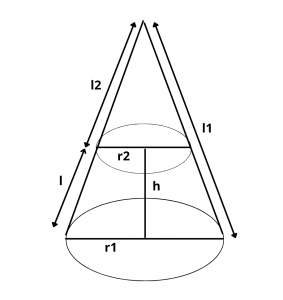Here you will learn formula for the total surface area and curved surface area of frustum of cone with derivation and examples.
Let’s begin –
What is Frustum of Cone ?
Frustum of a cone is the solid obtained after removing the upper portion of the cone by a plane parallel to its base. The lower portion is the frustum of a cone.
Height : The perpendicular distance between the aforesaid plane and the base is called the height of the frustum.
Area of a Frustum of a Cone
(i) Curved Surface Area (C.S.A) or Lateral Surface Area
C.S.A = \(\pi(r_1 + r_2)l\)
(ii) Total Surface Area (T.S.A)
T.S.A = \(\pi(r_1 + r_2)l\) + \(\pi{r_1}^2\) + \(\pi{r_2}^2\)
where \(l\) is the slant height of the frustum, \(r_1\), \(r_2\) are the radii of the base and the top of frustum of a cone.
Note : Height h of the frustum is given by the relation,
\(l^2\) = \(h^2\) + \((r_1 – r_2)^2\)
Also Read : Volume of a Frustum of a Cone – Formula and Derivation
Derivation :
Let \(r_1\) and \(r_2\) be the radii of the bottom and top of the frustum respectively and \(l\) be the slant height of the frustum.
Curved Surface area of bigger cone – curved surface area of smaller cone
= \(\pi r_1l_1\) – \(\pi r_2l_2\)
Since, [ \(l_1\over r_1\) = \(l_2\over r_2\) = k ]
= \(\pi[r_1(kr_1) – r_2l(kr_2)]\)
= \(\pi k\) \([{r_1}^2 – {r_2}^2]\)
C.S.A = \(\pi k\)\((r_1 – r_2)\)\((r_1 + r_2)\) = \(\pi\)\((kr_1 – kr_2)\)\((r_1 + r_2)\)
C.S.A = \(\pi\) \((l_1 – l_2)\)\((r_1 + r_2)\) = \(\pi l(r_1 + r_2)\)
= (semiperimeter of top and bottom) \(\times\) (slant height)
Total surface are of frustum = Curved surface area + area of top + area of bottom
T.S.A = \(\pi(r_1 + r_2)l\) + \(\pi{r_1}^2\) + \(\pi{r_2}^2\)
Example : A friction clutch is in the form of the frustum of a cone, the diameters of the ends being 8 cm, and 10 cm and length 8 cm. Find its bearing Surface area.
Solution : Here, radius,
\(r_1\) = \(10\over 2\) = 5cm,
\(r_2\) = \(8\over 2\) = 4cm
Slant height, l = 8 cm
Area of the bearing surface of the cone = \(\pi(r_1 + r_2)l\)
= 3.14(4 + 5) \(\times\) 8 = 226.08 \(cm^2\)
